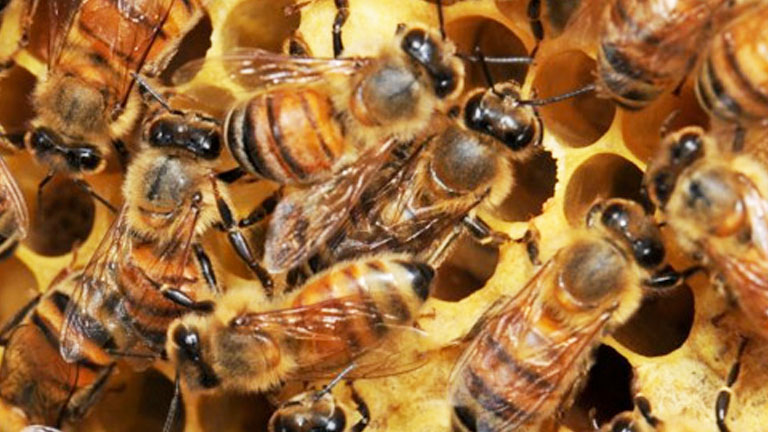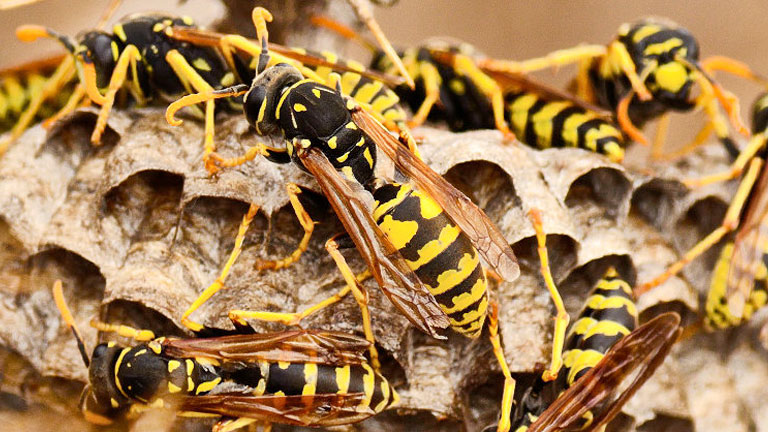Find your Bee Answers here:
What do I do if I hear or see bees?
- When you hear or see bees nearby, use caution and stay calm. If you see bees foraging on flowers, the bees are not defensive and will not bother you if you keep your distance from them. They are collecting pollen and nectar to take home for food. If you are the first to notice bees while with others, notify the group and keep them away. Stay alert to where the bees are in proximity to you or a group of people. If you are allergic to bee venom, consider bringing a companion with you when going outdoors where bees might be congregating.
- If you see a swarm of bees, which can be clumped into a ball or flying by as a unit, it is also best to keep your distance, but the bees are not generally defensive. This is because the swarm is in search of a new home, and not protecting brood and honey supplies. If the swarm is approaching you, seek shelter indoors if possible. If there is no shelter nearby, move away if possible and cover your face and neck for protection.
- If you see bees building a hive, stay as far away as possible. Bees that are protecting a hive will be more likely to exhibit defensive behavior and can become agitated. If the hive is on private property, it is the responsibility of the property owner to have the bees removed.
- If you see bees in boxes, those are managed apiaries being cared for by a beekeeper.
- If bees are bumping into you, this is their way of telling you that you are too close to their home. Move a safe distance away until they are no longer bumping you.
- The best way to be safe is to avoid surprising bee swarms or hives.
What do I do if I see a swarm of bees?
- If you see a swarm of bees, which can be clumped into a ball the size of a softball up to a basket ball or flying by as a unit, it is always best to keep your distance, but the bees are not generally defensive.
- This is because the swarm is in search of a new home, and not protecting brood and honey supplies. If the swarm is approaching you, seek shelter indoors if possible. If there is no shelter nearby, move away if possible and cover your face and neck for protection.
- If you see bees flying overhead in a large group, that is a swarm and they are trying to find a new home. The swarms land and form a cluster, and may land on a sidewalk, a car, the side of a house, or a tree. Swarms are only temporary and hang around usually just a couple of days. They are generally not a threat if left alone. Notify others of the swarms location and to leave it alone, if possible, rope off area or place a warning sign.
What do I do if being stung by several bees?
- Here are some basic safety measures to take if a sting were to occur.
- First, know where the nearest emergency facilities are located in case of an emergency.
- Only one or two people per thousand have a hyper-allergic reaction to bees, but if you do not know if you are allergic or not, be prepared.
- Symptoms of anaphylaxis appear immediately. They include: itching, swollen eyes, wheezing, swelling of the tongue, dizziness, shock, or cardiac arrest. If you see any signs of reaction, or are not sure, call 911 immediately.
- An average person can safely tolerate 10 stings per pound of body weight, meaning an average adult could withstand over 1000 stings, and a child over 500 stings.
- If you are stung, remain calm! Do not flail around or swat at any bees. Scrape the stinger out as quickly as possible, and wash or smoke the stung area to mask the alarm pheromone smell. Although a bee can only sting once and then dies, once you are stung, the pheromone left behind will incite other bees to sting you as well.
How do I get bees on my property removed?
- It is the responsibility of the property owner to remove a swarm or nest of bees on private property. The property owner should call a licensed pest control company or experienced beekeeper to have the bees.
- If you are renting, contact your landlord or property management company to notify them of the bee nest.
- If the bees are in your water meter, call your local water authority.
How do I get my neighbor to remove bees on their property?
- Let your neighbor know that bees are bothering you and you would like the property owner to remove them because it is a safety and pest hazard.
- Bees may cause structural damage to property if not removed or if removed after bees already have an established colony.
- The hive site may attract other pests like mice, rats, ants, moths and cockroaches.
- The property owner is liable for any harm bees may do to others. If your neighbor is reluctant to take action, consider offering your assistance in making arrangements for professional bee removal.
- You might be able to help by collecting cost estimates for the bee removal work or assist them with the financial obligation if that is an impediment.
Find your Wasp Answers here:
How are wasps different to bees?
Wasps and bees both belong to the order “Hymenoptera” and have many features in common. The most obvious differences are:
- wasps do not collect pollen, bees do
- wasps do not store food, bees do
- wasps do not make honey, bees do
- wasp nests are made of paper, bees nests are made of wax
- wasp mouth parts are designed to chew food, bees mouth parts are designed to lap liquid
- wasps can sting more than once, bees can only sting once
What is the venom that the wasp injects into you?
The principal component of venom is protein — it is the protein that causes allergy reactions in people. Several different proteins have been demonstrated in wasp venom, the total number and relative proportions vary among the different genera. Other components of venom include an acetylcholine-like substance, histamine, serotonin, and kinin. Kinins are peptides that cause slow contractions of isolated smooth muscle, lower arterial blood pressure, and increase capillary permeability.
Can wasps sting you if they are dead?
Yes — the venom sac at the end of a wasp sting keeps pulsing for a short period after a wasp dies, so if you come in contact with the sting you may still be injected with venom.
Why do wasps sting people?
Unprovoked wasp attacks are very rare, a wasp will normally only use its sting to defend itself or to subdue prey. Many wasps stings are the result of people squashing wasps, either deliberately or by accident. Wasps are attracted to food (especially fish sandwiches) and sweet drinks. People have been stung while they are eating because they have not seen the wasp that is also sharing the food. Or, in the case of drinks, they have not seen a wasp enter their drink container and are stung as they take a drink by a wasp who wants to escape being swallowed. Wasps also sting intruders to defend their nest. When a wasp nest is disturbed, wasps will fly out with a wing beat frequency that stimulates other wasps to fly out the nest and attack. They will attack an intruder within 7 metres of the nest and pay special attention to moving targets.
Why are wasps black and yellow?
Bright colors are a sign of danger. Many species that are venomous, like snakes, spiders, and wasps, are brightly colored, and this coloring warns potential predators that they are dangerous. A predator, that attacks a wasp and is stung will link pain associated with a sting with the yellow/ black coloration and avoid animals with this coloration in future.
Different colors are produced by the differential absorption and reflection of light. Absorption of light is due to pigments — the black coloration is produced by the pigment melanin, which occurs in the granular form within the cuticle, while the yellow colors are created by the pigment xanthopterin.
How many wasps can there be in a colony?
An average common or German wasp nest produces between 11 000 and 13 000 workers and from 1000 to 2000 queens a season.
Where do wasps build their nests?
Common wasps usually choose a warm spot, often in a bank with a sunny aspect, but they also seek attics, house roofs, eaves, or walls in which to build their nests.



